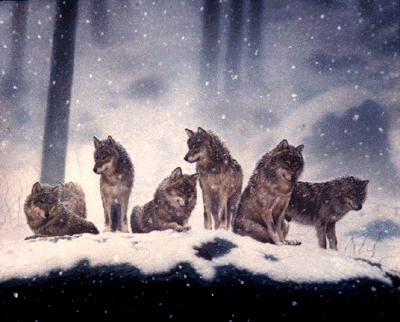The grey wolf - otherwise known as the timber wolf, white wolf or 'common' wolf - lives in a variety of habitats, from the Arctic tundra and open steppes of Russia, to the mountainous regions and forests of the northern hemisphere. It has a highly organised social structure which enables it to enjoy the maximum cooperation when hunting, communicating, and defending its territory.
 |
| Wolf facts |
The hierarchy that exists within each pack is maintained by dominant or submissive body posturing, as well as other behavioural patterns such as the communal care of the young.
The size of the pack's territory depends on the availability of prey, but usually covers several hundred square kilometres. The grey wolf is fiercely territorial.
It scent marks boundaries and makes its presence known by howling to other members of the pack. Calls may be answered by rival wolf packs.
Wolf facts
 |
| Wolf facts |
2. A wolf that has been driven from the pack, or has left on its own accord is called a lone wolf. It avoids contact with packs and rarely howls.
3. The wolf is the largest of the wild dog species.
4. Wolves are generally shy of people and will avoid them whenever possible. Most of the attacks on humans by wolves have been carried out by rabid animals.
5. Wolf packs in the far north often travel hundreds of kilometre following migrating herds.
 |
| Wolf chasing prey |
7. A Wolf in a hurry can go as fast as 35 miles per hour for short distances.
8. Wolves are highly intelligent animals. Studies indicate that the domestic dog's brain is 15% to 30% smaller than the wolf's.
9. The wolf has two types of hair: guard and undercoat. The long guard hairs repel moisture and the undercoat insulates. It sheds its bulky winter coat in sheets (unlike most dogs); females tend to lose their winter coats more slowly than males.
10. A wolf's hearing is at least 16 times sharper than a human's. Wolves can hear a sound as far as six miles away in the forest and ten miles away in open country. The wolf also has excellent peripheral vision and superior night vision. The outer perimeter of the wolf's retina is highly sensitive to movement. However, a wolf's eyes lack a foveal pit that allows for sharp focusing at long distances.
Breeding
 |
| Wolf pups |
Subordinate males and females compete for a higher place in the hierarchy of the pack, for it only the most dominant wolves that get the opportunity to mate. Unfortunately, the majority of wolves do not get to breed. Instead, they get to choose to help their siblings rear pups by hunting prey for them.
Once they have paired, the dominant male and female will mate once or twice a day over a period of about 14 days.
The female wolf will give birth after about nine weeks to between 3 and 10 cubs. The birth occurs in an underground den that she would have excavated herself. However, she will sometime enlarge the disused den of another animal.
The young are born helpless and their eyes are closed. The mother will feed the cubs for 6 to 8 weeks, and - if she has to leave them - the father or another babysitter will guard them.
Gradually, the cubs will learn to eat meat brought to them in the den by adult wolves. The adult will sometimes carry the meat in its mouth, but over long distances it will swallow it, only to regurgitate it later at the den.
For more information click onto:
MOOSE FACTS
THE COYOTE
WHERE DO WOLVES LIVE?
WHAT DOES A WOLF EAT?
WOLF FACTS







No comments:
Post a Comment